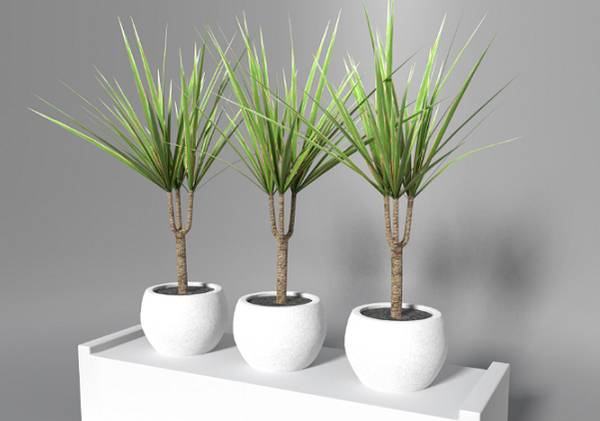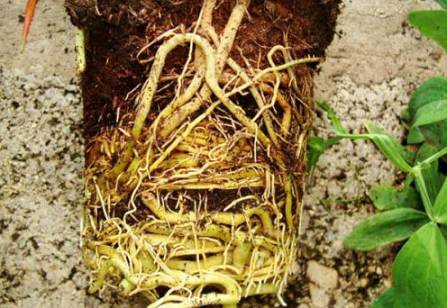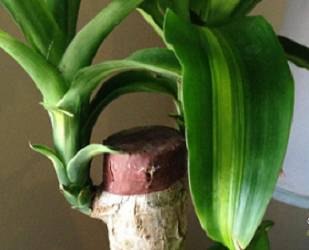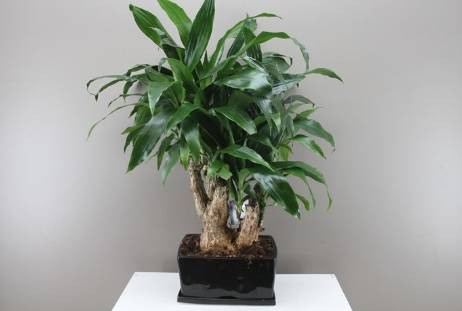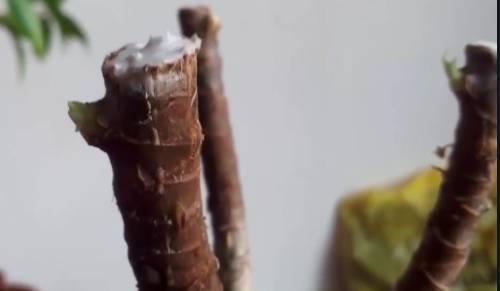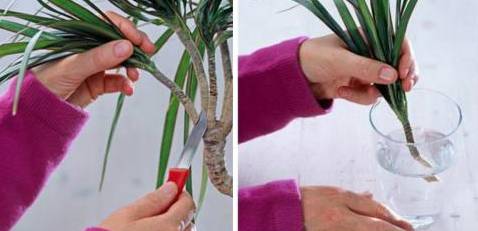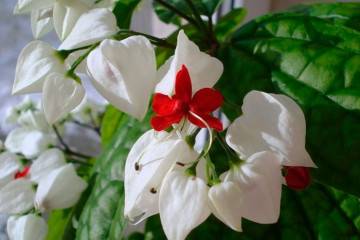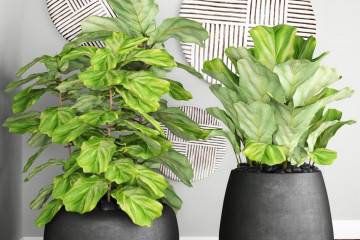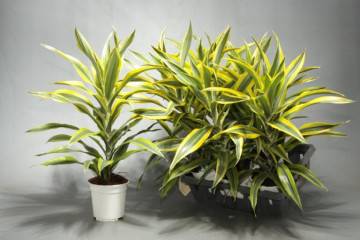How to trim Dracaena at home
Content:
Dracaena pruning is one of the main components of plant care. The procedure helps prevent certain diseases. Below it is considered whether it is possible to trim the dracaena in certain cases, why it should be done and what pruning methods exist.
The importance of pruning regularly
For dracaena, pruning is extremely important. It is carried out if the plant:
- has lost aesthetic appeal;
- disproportionately "stretched out";
- got sick or broken off.
Dracaena grows up very quickly, begins to break off, bend. The optimal height for a palm tree is 40 cm. It is this value that is considered the best for maintaining decorative qualities and compactness. Pruning, according to this principle, is also carried out in order to rejuvenate the false palm.
Even if pinching has already been carried out to form the crown, you need to do it again. Otherwise, the palm tree will grow further and lose its former attractiveness. It is pruning that often allows you to save a perennial in case of illness, fragments of a trunk, branches.
All types of false palms grown at home must be pruned, the only difference is in the frequency. At home, the following are most often cultivated:
- dracaena unfolded. A small perennial growing up to 1 m in a room has xiphoid, sharp leaves up to 20 cm, extending directly from the root of the branch. The plant is more like a bush, needs little pruning;
- dracaena escaping. It differs from other types of dracaena, because the stems branch. Outwardly, the plant resembles a fluffy shrub. It has succulent oval-shaped leaves with white, beige specks, shoots up to 90 cm high;
- fragrant dracaena. Recommended for professional cultivation. The plant has a thick, poorly branched trunk. At home, it grows up to 3.5 m. Its glossy dark green leaves with light stripes reach half a meter in length. It is very difficult to form a crown by pruning;
- marginata or Madagascar dragon tree. Grows up to 2 m tall. It has a lignified stem, thin long leaves with a reddish border. The appearance of the palm tree is most often associated with Dracaena Marginata.
After it has been decided to update the dracaena, you should find out at what time it is best to do it. The most suitable time is April-May. During this period, the plant begins sap flow, the production of phytohormones (cytotoxins, auxins). These processes stimulate the development of lateral shoots, they will also provide the wound with rapid overgrowth.
To the question: is it possible to prune Dracaena in winter or autumn, the answer is one - it is impossible. Reduced activity, susceptibility to infections during this period can destroy it. Pruning of a false palm is allowed at this time only if:
- stem breakage;
- decay of the shoot or pest damage.
Preparing for the procedure
Preparation for the pruning procedure is as follows:
- it is necessary to allow the plant to acclimatize after transplanting or "moving" to a new house;
- it is important to determine the height, because the main trunk will not grow after pruning;
- a few days before the scheduled procedure, water and spray the dracaena with "Epin". This drug will help the plant survive the shock by strengthening the immune system;
- you need to pick up sharp instruments, disinfect them - ignite over a fire or treat with alcohol. To trim the stem, take a knife, for the leaves - a pruner.
Pruning for side shoots
The unaesthetic appearance of dracaena often prompts the owner to prune in order to obtain side shoots. The reasons may be as follows:
- difficulties in leaving due to the fact that the plant is stretched to the ceiling;
- naked, deformed stem, crooked shoots look bad.
Here is a step-by-step plan on how to prune a dracaena to get side shoots:
- decide on the future height of the plant trunk. If the trunk of the dracaena is higher than 30 cm from the ground to the crown, then it is usually shortened, retreating 10 cm from the top;
- make a horizontal cut with a clean, sharp knife. Torn edges, crushing are inadmissible;
- the section should be protected from infections with garden varnish or wax;
- the place of the cut is wrapped in moss or polyethylene to create a greenhouse effect. Remove the "protection" only after the appearance of the kidney.
The false palm has dormant buds in a spiral, so you don't have to worry about the growth of new leaves. Florists usually leave three strong shoots so that they freely diverge along the trunk of the palm tree.
Sanitary pruning
Sanitary pruning is used to remove affected leaves, shoots, and prevent diseases.
Most of the diseases of dracaena are the result of inadequate care: drafts, dry air, improper watering. Because of this, the leaves of the plant turn yellow and fall off, the trunk is bare. Such problems are solved with the help of fungicides and subsequent sanitary pruning.
This procedure is carried out according to the classical scheme. Sterile instruments cut off damaged shoots to the maximum. The sections are disinfected and sealed.
Root update
If the dracaena looks dull: the tops lose turgor, the lower part of the cellar has become soft, then this often indicates a poor condition of the roots. And how to update dracaena at home if the roots are affected?
The first step is to remove the plant from the pot, remove the rest of the soil so as not to transfer the infection to new soil. It is important to separate only what separates well, the rest is removed after soaking in water.
The healthy roots of the false palm look like orange smooth laces without knots. Rotten or affected by the fungus become empty from the inside, the upper fabrics are removed with a cover. In this situation, you need to trim the diseased parts of the plant. There should be no trace of decayed areas.
The "operation" should be done with a sharp knife or pruner. After removing the affected parts, the root is soaked in a solution of potassium permanganate. The sections must be covered with wood ash, a stimulant powder for disinfection, and planted in clean soil.
If rot has affected both the root system and the trunk, then it is better to completely cut off the lower part of the plant. This will create an apical stalk, which is placed in water for further rooting. There you can add activated carbon, "Kornevin".
Dracaena palm: how to prune for branching
This pruning method can be carried out when the leaves are shedding or to give the crown a splendor. Standard technology is used for this. Pruning dracaena for branching, like an operation, is carried out with a sharp knife. In this case, the top of the flower is cut off and sealed with paraffin (wax). If the plant has 2-3 branches, then they are all cut off, leaving 2-3 buds that have hatched dormant in each.
After the procedure, the plant is placed away from direct rays. Temperature control is important, it is kept within 22-24 ºС. If the palm tree has already been pruned, but it has grown, it is necessary to do it again.
The tops are often cut at different heights. This will give the plant additional volume, multi-tiered. The horizontal insertion between the stems will also help add fluffiness to the perennial.
Dracaena rejuvenation with pruning
The lower leaves of a perennial often fade with age, crumble, exposing the trunk. He, in turn, also becomes unattractive - bends, lengthens. How to rejuvenate dracaena with pruning? The procedure consists in shortening the old trunk. Its minimum recommended height is 5 cm, however, you can cut the plant to the base, leaving 3 dormant buds.
The cut must be open until overgrown. In order for the lateral buds to enter the activity phase (become the central trunks), the place below the cut is lubricated with a growth stimulator and covered with moss.
Bonsai pruning
Bonsai is the art of growing miniature trees. Literally translated as "a tree in a bowl." This art originated in China and Japan, therefore oriental trees are more often used. Bonsai can also be grown from the usual indoor plants, such as, for example, dracaena.
Such a design of a plant is not a matter of one year. A true bonsai from a false palm is difficult to obtain, as it can grow quite tall, and many varieties have large leaves. However, you can try. Here are some tips on how to create a bonsai-style dracaena at home:
- it is necessary to take a plant no more than 30 cm high, with a developed crown;
- before placing the dracaena in a special bowl, the roots are cut by a third. Subsequently, they are pruned once every two years;
- after transplantation, the root collar should look out of the ground by 1-2 cm;
- the cut of the main trunk is carried out with a diameter of about 5 cm;
- the lateral trunks are shortened as close to the base as possible, this leads to the appearance of additional sprouts (tops). Also, as a result of this, the main trunk will become thick;
- then cutting the following branches is carried out;
- on the central trunk, one strong sprout can be left, which will produce leaves, and the rest can be systematically removed.
The formation of the crown is carried out by such pruning. The owner should be patient.
Caring for dracaena bonsai is very difficult. The plant should not lack moisture. To do this, moss should be planted in the ground near the tree, it retains water. It is important to spray the perennial regularly; there should be wet gravel in the pallet all the time. It is necessary to remove dust from the leaves in a timely manner, cut off dry ones.
Dracaena care after pruning
After trimming, the correct processing of the cut is important; it should be "sealed" with paraffin or wax to prevent moisture evaporation. To do this, light a candle and drop a few drops on the cut surface. If juice flows from the "wound", wipe it with cotton wool.
It is necessary to determine the flow of light that will fall on the plant after renewal. This fact will also help in adjusting the future height of the stem. It is better to place a perennial near the east or west window.
Palm owners should know how to grow many new dracaena at once by pruning the tops. In fact, this is one of the ways of its reproduction.
For this purpose, only healthy shoots are used. After drying for 48 hours, the cutting is placed in plain water, immersed in a moss pillow or hydrogel. For better germination, it is advisable to make a greenhouse from polyethylene. Root pecking occurs after about 30 days. When this happens, the plant is transplanted into stationary soil.
Possible pruning problems
If the dracaena has completely lost its leaves, watering should be cut, otherwise the root may rot. When exposing the plant to the light, it is important to rotate it periodically for the full development of the buds.
One of the complications of circumcision is tip decay. This happens due to infection of the injured tissue. In this case, you need to do the trimming again, below the damaged area, in compliance with all the rules.
Dracaena pruning is a necessary procedure for the tree to be healthy. Also, the plant is pruned to give it an attractive appearance.
